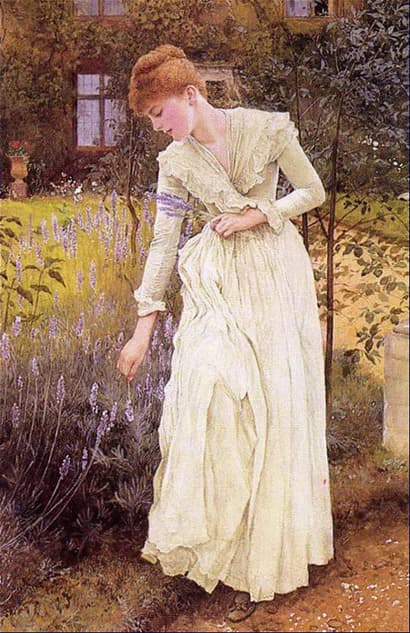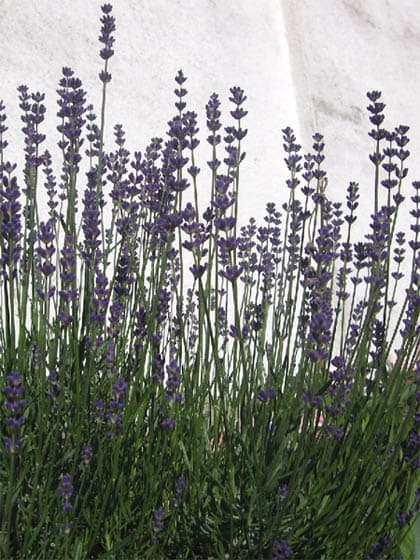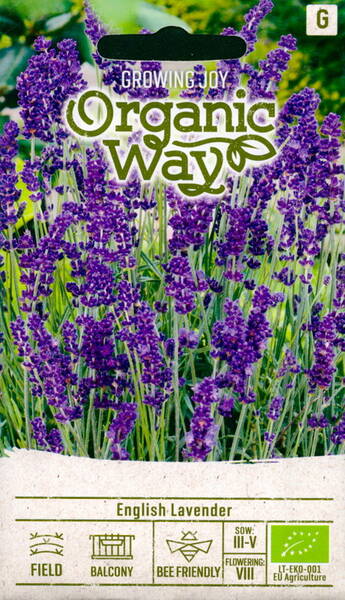A beautiful fragrant plant. Excellent honey plant.
A perennial evergreen shrub up to 60 cm high. The plant is highly branched, with narrow grayish-green leaves, forming a compact bush. Blue-violet flowers are collected in spike-shaped inflorescences. The plant prefers dry, sunny places. Blooms in late July.
Fresh herbs are used as a seasoning. In folk medicine, flowers are used as a sedative, choleretic agent. Alcohol tinctures are used for rheumatic pains, neuralgia, etc.
It is used in perfumery and as a remedy for moths.
Agricultural technology: propagated by seeds, root cuttings (in spring). To increase germination, it is recommended to carry out stratification. The seeds are sown in boxes with light sandy soil, kept at T +3..+5 °C for 2-4 weeks, and then at a temperature of + 20 °C for 6-8 weeks. Seedlings are planted in early June according to the 30x30 cm scheme.In the middle lane for the winter, the bushes are mulched with peat, wood shavings, etc.
Cut off the stalks after flowering. In the spring, all old shoots are cut out. Carefully dig up the lavender curtain with a clod of earth. Use a shovel to cut the lump so that each of the parts obtained has rooted shoots. Plant each plot separately.

Johnson Edward Killingworth.


Common lavender, English lavender, true lavender. Bot. syn.: Lavandula delphinensis Jord ex Billot, Lavandula officinalis Chaix., Lavandula spica L., Lavandula vera DC.
* Common Lavender.
Origin: Southern Europe.
A perennial semi-shrub with a woody, fibrous root system reaching two meters in length and numerous shoots up to 60 cm tall, woody at the base. Leaves are opposite, dense, sessile, linear, silvery-greenish-gray, with a delicate pubescence.
Flowers are small, bisexual, bluish-lilac or blue. They are gathered in interrupted spike-like inflorescences of 6-10 flowers in whorls, spaced 0.5-2 cm apart on the tips of leafless stems. Inflorescences can range in color from violet-blue to deep lilac. The labiate flowers are gathered in long spikes and have a very pleasant fragrance.
Flowering period: July - August.
In horticulture, another variety of medicinal lavender is known - delphinium-leaved (var. deiphinensis), which reaches only 30 cm in height and has exceptionally decorative silvery foliage.
Furthermore, there are several cultivars, bred mainly in England, for example:
"Alba" - white inflorescences, 50 cm;
"Rosea" - lilac-pink inflorescences, 40 cm;
"Munstead" - rich blue inflorescences, 40 cm, compact, reliable shrubs;
"Hidcote Blue" - violet-blue, 40 cm, compact, reliable bushes;
"Hidcote Giant" - up to 60 cm tall, distinguished by a compact bush shape.
Location: Grows well in a sunny, warm (even hot) spot.
Soil: Dry, fresh, well-draining, gravelly or sandy-clay, moderately nutritious, containing lime.
Lavender cannot grow on heavy clay soils with high acidity and a high water table.
Prepare a light and fertile soil mixture from leaf mold, humus, and sand in a ratio of 3:2:1, adding a complete mineral fertilizer at a rate of 20 g per planting hole.
Planting: Plants are placed 30-40 cm apart. Planting depth is 25-30 cm.
Care: Prune regularly in spring. Water abundantly during dry weather.
In Estonian conditions, it needs reliable winter protection (spruce branches, pine needles are suitable). If the above-ground part does freeze, it is pruned, and the plant usually recovers. The same pruning technique is used regularly to rejuvenate the bushes and prevent them from becoming bare at the bottom.
Propagation: By cuttings.
Can also be propagated by seeds: seeds require stratification for 30-40 days at a temperature of +5°C.
Sow for seedlings in late February - early March at a depth of 3 mm. Seeds germinate in light at temperatures of +15 to +21°C.
When the seedlings have grown, transplant them 5 cm apart. In May, plant the seedlings in their permanent location.
Seeds can also be sown in beds in autumn, in late October. Seedlings will then appear in spring, in late May.
For cuttings, take woody one-year-old shoots, cut them into 8-10 cm long segments, and root them.
For propagation by division, prune the plants to a height of 8-10 cm in autumn and hill them with soil, carefully filling the space between the stems. In spring, add more soil around the bushes.
During the summer, lavender produces abundant shoots that root well. In autumn, dig up the bush and divide it.
Another simple method of propagating lavender is by layering. In spring, carefully bend 2-3 shoots and place them in a shallow (3-5 cm) trench, pin them down, cover with soil, and water. The soil here should be slightly moist throughout the summer. Usually, by the following spring, the shoot can live on its own and is cut from the mother plant.
Use: Near terraces, in gardens with fragrant herbs.
Companions: Shrubs or semi-shrubs that prefer dry soil. Grows well with roses.
* Lavender Lemonade.
To prepare it you will need: 1.5 L of water, 100 g of honey, 3 lemons, 1 drop of lavender oil.
Squeeze the lemon juice. Pour the lemon juice, water, and lavender oil into a large pitcher. Add honey (it's better to use liquid honey so it dissolves faster). You can adjust the amount of water and honey to taste, but be very careful with the amount of lavender oil!
This cocktail is good for neutralizing headaches and relieving depression, contributing to overall body wellness.












